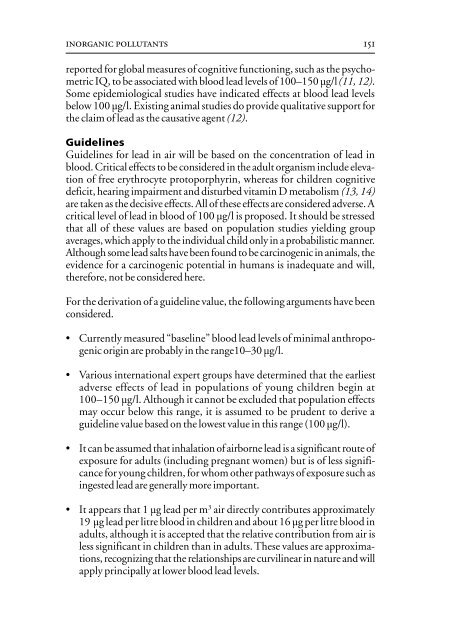Air Quality Guidelines - World Health Organization Regional Office ...
Air Quality Guidelines - World Health Organization Regional Office ...
Air Quality Guidelines - World Health Organization Regional Office ...
Create successful ePaper yourself
Turn your PDF publications into a flip-book with our unique Google optimized e-Paper software.
inorganic pollutants<br />
reported for global measures of cognitive functioning, such as the psychometric<br />
IQ, to be associated with blood lead levels of 100–150 µg/l (11, 12).<br />
Some epidemiological studies have indicated effects at blood lead levels<br />
below 100 µg/l. Existing animal studies do provide qualitative support for<br />
the claim of lead as the causative agent (12).<br />
<strong>Guidelines</strong><br />
<strong>Guidelines</strong> for lead in air will be based on the concentration of lead in<br />
blood. Critical effects to be considered in the adult organism include elevation<br />
of free erythrocyte protoporphyrin, whereas for children cognitive<br />
deficit, hearing impairment and disturbed vitamin D metabolism (13, 14)<br />
are taken as the decisive effects. All of these effects are considered adverse. A<br />
critical level of lead in blood of 100 µg/l is proposed. It should be stressed<br />
that all of these values are based on population studies yielding group<br />
averages, which apply to the individual child only in a probabilistic manner.<br />
Although some lead salts have been found to be carcinogenic in animals, the<br />
evidence for a carcinogenic potential in humans is inadequate and will,<br />
therefore, not be considered here.<br />
For the derivation of a guideline value, the following arguments have been<br />
considered.<br />
• Currently measured “baseline” blood lead levels of minimal anthropogenic<br />
origin are probably in the range10–30 µg/l.<br />
• Various international expert groups have determined that the earliest<br />
adverse effects of lead in populations of young children begin at<br />
100–150 µg/l. Although it cannot be excluded that population effects<br />
may occur below this range, it is assumed to be prudent to derive a<br />
guideline value based on the lowest value in this range (100 µg/l).<br />
• It can be assumed that inhalation of airborne lead is a significant route of<br />
exposure for adults (including pregnant women) but is of less significance<br />
for young children, for whom other pathways of exposure such as<br />
ingested lead are generally more important.<br />
• It appears that 1 µg lead per m 3 air directly contributes approximately<br />
19 µg lead per litre blood in children and about 16 µg per litre blood in<br />
adults, although it is accepted that the relative contribution from air is<br />
less significant in children than in adults. These values are approximations,<br />
recognizing that the relationships are curvilinear in nature and will<br />
apply principally at lower blood lead levels.<br />
151

















